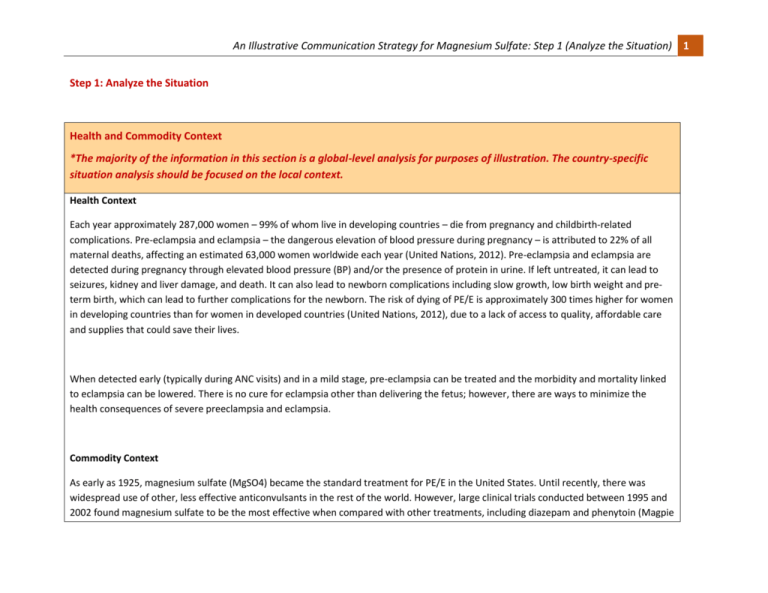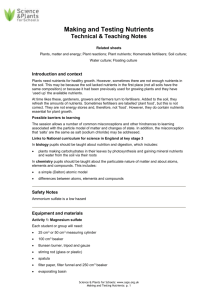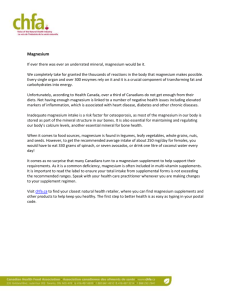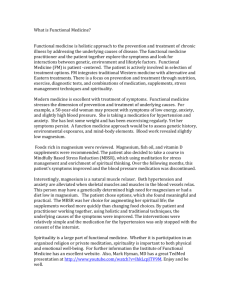Illustrative Examples for Magnesium Sulfate situation
advertisement

An Illustrative Communication Strategy for Magnesium Sulfate: Step 1 (Analyze the Situation) 1 Step 1: Analyze the Situation Health and Commodity Context *The majority of the information in this section is a global-level analysis for purposes of illustration. The country-specific situation analysis should be focused on the local context. Health Context Each year approximately 287,000 women – 99% of whom live in developing countries – die from pregnancy and childbirth-related complications. Pre-eclampsia and eclampsia – the dangerous elevation of blood pressure during pregnancy – is attributed to 22% of all maternal deaths, affecting an estimated 63,000 women worldwide each year (United Nations, 2012). Pre-eclampsia and eclampsia are detected during pregnancy through elevated blood pressure (BP) and/or the presence of protein in urine. If left untreated, it can lead to seizures, kidney and liver damage, and death. It can also lead to newborn complications including slow growth, low birth weight and preterm birth, which can lead to further complications for the newborn. The risk of dying of PE/E is approximately 300 times higher for women in developing countries than for women in developed countries (United Nations, 2012), due to a lack of access to quality, affordable care and supplies that could save their lives. When detected early (typically during ANC visits) and in a mild stage, pre-eclampsia can be treated and the morbidity and mortality linked to eclampsia can be lowered. There is no cure for eclampsia other than delivering the fetus; however, there are ways to minimize the health consequences of severe preeclampsia and eclampsia. Commodity Context As early as 1925, magnesium sulfate (MgSO4) became the standard treatment for PE/E in the United States. Until recently, there was widespread use of other, less effective anticonvulsants in the rest of the world. However, large clinical trials conducted between 1995 and 2002 found magnesium sulfate to be the most effective when compared with other treatments, including diazepam and phenytoin (Magpie An Illustrative Communication Strategy for Magnesium Sulfate: Step 1 (Analyze the Situation) 2 Trial Collaborative Group, 2002). These trials have found magnesium sulfate to reduce the occurrence of eclampsia by more than 50% and maternal deaths by 46%. Women treated with magnesium sulfate had a 52% and 67% lower recurrence of convulsions (eclampsia) than those treated with diazepam and phenytoin, respectively. Magnesium sulfate has since been placed on the World Health Organization (WHO) Essential Medicines List and is recommended as the most effective, safe and affordable treatment for severe PE/E. Magnesium sulfate costs approximately US $0.10 per ml (supplier median price), or US $1 per dose, and is produced by a number of global manufacturers and many local manufacturers worldwide. Magnesium sulfate is available in a variety of formulations, including a 50% solution of 500 mg/ml in a 2-ml ampoule, and a 20% solution of 500 mg/ml in a 10-ml ampoule (EWEC magnesium sulfate product profile, 2013). A treatment may require up to nine vials. Magnesium sulfate is administered by injection into the woman’s vein or muscle. Calcium gluconate—a mineral supplement—is an antidote available in the rare event of magnesium sulfate side-effects or toxicity, including flushed appearance, headaches, slurred speech, nausea, loss of reflexes, respiratory paralysis, and abnormal heart rates or cardiac arrest. Around 35 manufacturers of generic magnesium sulfate solutions have been identified worldwide, but there are likely to be other manufacturers around the world, especially in Asia and Latin America. Products are available in sealed glass ampoules or vials sealed with a rubber or latex stopper and cap. The product is very stable at ambient temperatures and is unlikely to undergo any significant degradation as a result of heat if it is properly manufactured, packaged, sterilized and sealed. Recent consultations among experts have led to the recommendation of one particular dosing: 5g in 10mL. Audience and Communication Analysis Common barriers to uptake of magnesium sulfate across multiple country contexts include a lack of political will, lack of country specific An Illustrative Communication Strategy for Magnesium Sulfate: Step 1 (Analyze the Situation) 3 clinical guidelines for administration, low availability of the medication and related supplies, lack of confidence among health care providers to use magnesium sulfate, poor knowledge and understanding of the symptoms of PE/E at the community level, inaccuracies about dosage calculation and administration and lack of provider and community knowledge about magnesium sulfate, including concern about side effects for the mother and fetus (Health Communication Capacity Collaborative, 2014; Maternal Health Technical Resource Team, n.d.). Even when health care providers understand the severity of PE/E ,they often fail to treat due to lack of clinical guidelines and standards, lack of knowledge about appropriate treatment and lack of skills to administer magnesium sulfate (EngenderHealth, 2007). Lack of Political Will and Structural Barriers: Although the effectiveness of magnesium sulfate has long been established and many countries have magnesium sulfate in their EMLs, increased political will is necessary to ensure that magnesium sulfate is available and that international clinical guidelines are translated into local clinical practice. Country experiences in Nigeria, South Africa, Zimbabwe and Mozambique highlight the need to combine advocacy efforts with collaborative protocol development and health care provider training to obtain positive results in the use of magnesium sulfate (Tukur et al., 2012; Woelk et al., 2009; Daniels et al., 2008). Regulatory hurdles can also restrict use of magnesium sulfate. For example, in many countries, lower level providers (such as midwives in the Democratic Republic of Congo) are not authorized to administer magnesium sulfate and therefore cannot stabilize a patient before referral if needed. Lack of Appropriate Clinical Guidelines: In some countries, drugs such as diazepam are listed as first line treatment for severe PE/E, even when the evidence shows that magnesium sulfate is more effective. In other countries, national treatment guidelines for magnesium sulfate are unavailable, and health providers may lack knowledge about proper use (PATH, UNFPA and USAID, 2012). For some countries, such as Kenya, recent guidelines have been adopted reflecting WHO recommendations but still need to be disseminated to the facility level. Registration/Procurement Issues: In several countries, poor procurement and distribution systems are responsible for low availability of the drug. In Pakistan, a study found that a fragmented system for registration, procurement and distribution was at the source of the low use of magnesium sulfate even though policies were all aligned with international standards (Bigdeli et al., 2013). Similarly, in Mozambique and Zimbabwe, where the procurement system is complex and cumbersome and the market for magnesium sulfate is relatively small, it is typically ordered by central medical stores only in response to requests from local physicians or specialists (Sevene et al., 2005). As a An Illustrative Communication Strategy for Magnesium Sulfate: Step 1 (Analyze the Situation) 4 consequence, it may not be readily available or available in sufficient quantities when needed. A recent study of 37 countries across Africa, Asia and Latin America found that more countries (86%) reported regular availability of magnesium sulfate at Ministry of Health stores than at facilities (76%), reflecting a supply chain and distribution problem (Smith et al., 2012). Availability of Supplies: A limited supply of magnesium sulfate at the health care facility is a barrier to its use, as are the high costs of some related supplies, including the antidote drug calcium gluconate, which tends to be absent from many health facilities where treatment is expected to be administered. The unavailability of this drug is a deterrent for providers to use magnesium sulfate. Similarly, supplies required for testing protein in urine to detect PE may be difficult to access, may not be available at the point of use or are expensive and are thus used sparingly (VSI/JHPIEGO Kenya, 2013). Provider Awareness, Knowledge and Confidence: Provider awareness of severe pre-eclampsia and the need to treat it with magnesium sulfate varies across countries. Pre-eclampsia is best detected during ANC visits through systematic testing and analysis of urine specimens. However, DHS data from various countries show that fewer than 40% of pregnant women get their urine tested regularly. This is due to a combination of factors. In many countries, there is a lack of emphasis on PE/E during ANC due to a stronger focus on HIV/AIDS in recent years. Furthermore, while ANC providers in many countries are trained to detect PE/E using urine tests or a range of known danger signs, blood pressure (BP) is still the most commonly used indicator of PE during ANC visits, even though BP machines are sometimes unreliable and/or difficult to read. Typical danger signs such as oedema (swelling due to fluid particularly in the feet, ankles, legs, or face), epigastric pain (pain experienced in the upper abdomen, below the ribs) and blurred vision are seldom asked about by providers during ANC visits (Sanghvi, n.d.). Knowledge and skills in treatment protocols are also lacking in many countries. For example, in Pakistan, most providers are aware of magnesium sulfate as the first-line treatment for eclampsia, but many are not aware of its use for severe pre-eclampsia (Bigdeli et al., 2013). In Kenya, providers often decide on treatment when observing “impending eclampsia”, which does not align with most recent protocols, which state that all cases of severe pre-eclampsia be treated with magnesium sulfate (and a hypertensive), with no consideration given to whether eclampsia is impending or not (VSI/JHPIEGO, 2013). Even with adequate supplies and diagnosis, providers may be reluctant to use magnesium sulfate to treat severe pre-eclampsia and eclampsia due to a fear of adverse effects and complexity of An Illustrative Communication Strategy for Magnesium Sulfate: Step 1 (Analyze the Situation) 5 administration. Incorrect knowledge regarding potential side effects to mother and unborn child also leads to reluctance in timely administration of magnesium sulfate. Preparation and Administration of Magnesium Sulfate: An important barrier at the facility level is the preparation and administration of magnesium sulfate. Providers in Pakistan reported that dosage preparation is one of the biggest barriers for them to use magnesium sulfate, as they must recall, calculate, and prepare the dosage themselves (Bigdeli et al., 2013). In Mexico, providers report that the time it takes to find and prepare magnesium sulfate can be a disincentive to its use, preferring instead a more readily accessible and less timeintensive drug such as diazepam (van Dijk et al., 2013b). In Kenya, the product was found to be available at the point of use in various concentrations and presentations, leading to confusion among providers about which product to use and how to calculate the right dosage (VSI/JHPIEGO 2013). Lack of Awareness Among Pregnant Women and at Community Level: Typical danger signs of PE/E are not well known among pregnant women (Sanghvi, n.d.). In countries with trained community health workers (CHWs), the content of training around danger signs in pregnancy may not include all the known danger signs for pre-eclampsia. In addition, CHWs may be aware of danger signs and symptoms but not understand the seriousness of the condition that they were witnessing. This can easily lead to missed opportunities for referral and urgent care. Example of Table to Organize Key Information An Illustrative Communication Strategy for Magnesium Sulfate: Step 1 (Analyze the Situation) 6 End-user/community members (e.g. women, their families) Providers (incl. public and private, clinic- and community-based) Current Behaviors Primary Barriers to Desired Behavior Primary Benefits of Desired Behavior Poor treatment seeking when experiencing common danger signs of PE/E Very limited awareness of PE/E danger signs, its serious consequences, and availability of treatment by pregnant women and CHWs Most effective PE/E treatment method Lack of or irregular PE/E screening during ANC Magnesium sulfate availability issues Most effective treatment for PE/E Low levels of promotion and use of magnesium sulfate Lack of commodity awareness (as front-line treatment) and country-specific guidelines for use Confusion over dosage and fear of adverse effects and incorrect administration High cost or unavailability of related supplies, such as antidote drug calcium gluconate and urine test equipment Rare occurrence of side-effects







